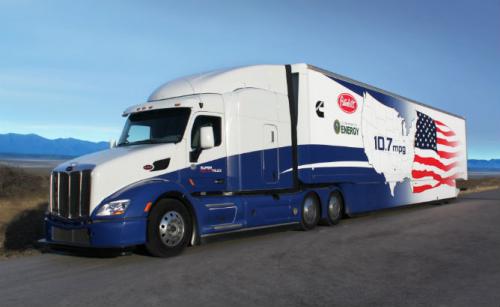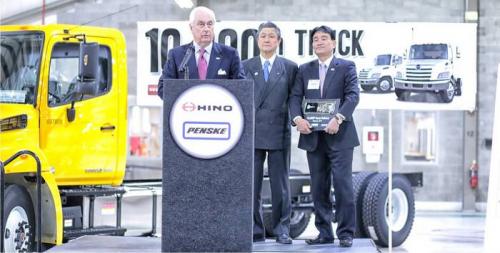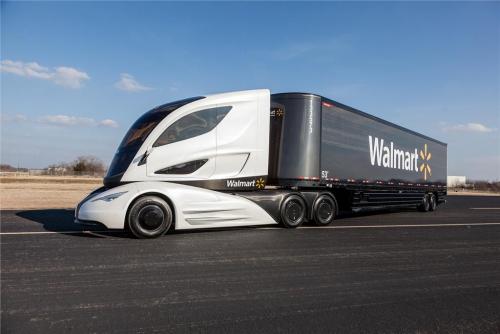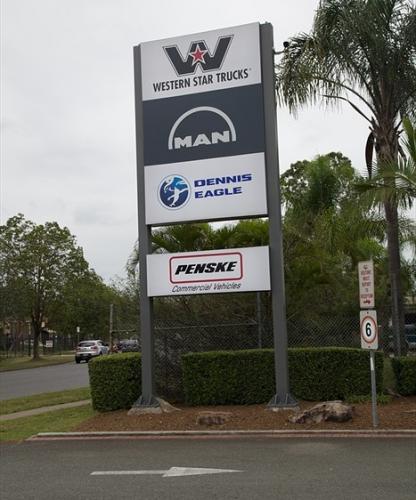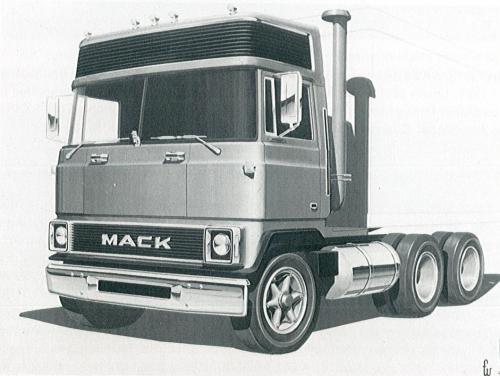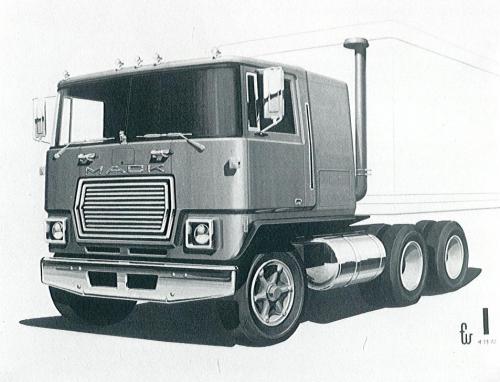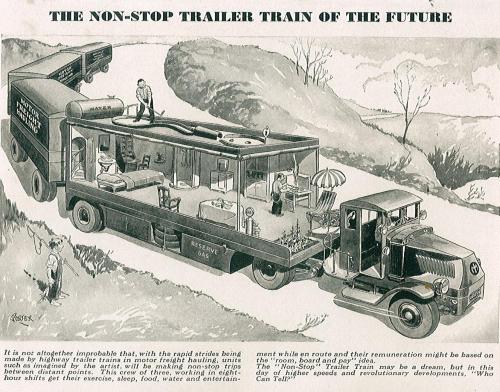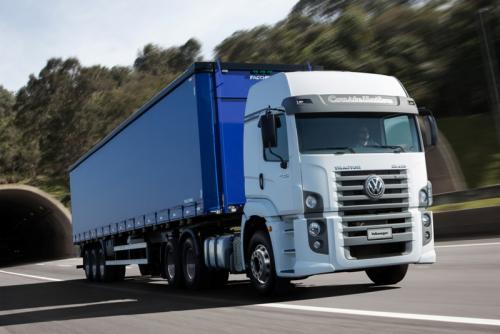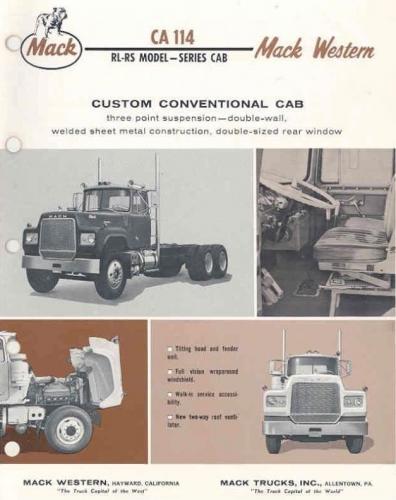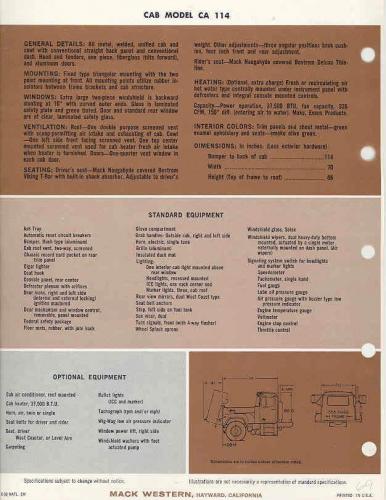
kscarbel2
Moderator-
Posts
17,891 -
Joined
-
Days Won
86
Content Type
Profiles
Forums
Gallery
Events
Blogs
BMT Wiki
Collections
Store
Everything posted by kscarbel2
-
Wall Street Journal / February 18, 2014 Cummins and Peterbilt announced today that the latest version of their SuperTruck demonstration tractor-trailer achieved 10.7 mpg last month under real-world driving conditions. Developing a truck that could meet or exceed 10 mpg when fully loaded was considered unlikely, if not impossible, just a few years back, with most trucks averaging between 5.5 and 6.5 mpg. However, with advances in engines, aerodynamics and more, SuperTruck has proven that 10 mpg is attainable. SuperTruck averaged a 75 percent increase in fuel economy, a 43 percent reduction in greenhouse gas (GHG) emissions and an 86 percent gain in freight efficiency in 24-hour, head-to-head testing against a 2009 baseline truck -- all significant improvements. The Cummins-Peterbilt SuperTruck was on display today for President Barack Obama's announcement of firm deadlines for the next generation of national fuel-efficiency and GHG emissions standards for heavy-duty commercial vehicles. The goal of the SuperTruck program, initiated by the U.S. Department of Energy (DOE), is to improve long-haul Class 8 vehicle freight efficiency. The program focuses on advanced and highly efficient engine systems and vehicle technologies that meet prevailing emissions and Class 8 tractor-trailer vehicle safety and regulatory requirements. In addition to the benefits of reduced fuel consumption and petroleum usage, the improvements in engine system efficiency will deliver a significant reduction in GHG emissions. Cummins has partnered with Peterbilt Motors Co. for the SuperTruck project. The project objectives have included development and demonstration of a highly efficient and clean diesel engine, an advanced waste heat recovery system, an aerodynamic tractor and trailer combination and a lithium ion battery-auxiliary power unit, to reduce engine idling. The Cummins-Peterbilt SuperTruck uses the Peterbilt Model 579, with best-in-class aerodynamic efficiency. The engine, based on Cummins industry-leading ISX15, converts exhaust heat into power delivered to the crankshaft, and has electronic control software that uses route information to optimize fuel use. The SuperTruck also includes chassis refinements, improvements in the aerodynamics and other significant advances in the engine. Lightweighting throughout the tractor-trailer also enables increased freight efficiency. Eaton, also part of the Cummins-Peterbilt SuperTruck project team, is developing a next-generation automated transmission (AMT) that improves fuel efficiency in heavy trucks. Eaton's contribution includes the design, development and prototyping of an advanced transmission that facilitates reduced engine-operating speeds. Cummins and Eaton jointly designed shift schedules and other features to yield further improved fuel efficiency. This demonstration of the Cummins-Peterbilt SuperTruck has exceeded DOE goals for freight efficiency -- a key trucking metric based on payload weight and fuel efficiency expressed in ton-miles per gallon. The SuperTruck achieved an 86 percent improvement in freight efficiency and a 75 percent fuel economy improvement over a 24-hour test cycle in December 2013. The program goal was a 68 percent freight-efficiency increase over a 2009 vintage baseline vehicle of the same weight traveling along the same route. "We are honored that the Cummins-Peterbilt SuperTruck has been chosen to be on display for President Obama's announcement," said Wayne Eckerle, Cummins Vice President - Research and Technology. "The SuperTruck clearly demonstrates the technologies that can deliver significant fuel-efficiency improvements over the next decade and beyond as we continue to develop for cost and performance attributes that will make them strong commercial successes." Landon Sproull, Peterbilt Chief Engineer, agreed. "The work we're doing on SuperTruck is very much in keeping with Peterbilt's global reputation for industry-leading design, innovative engineering and fuel-efficient solutions," he said. "I think it's been a terrific opportunity for us to look into the future and demonstrate what's possible." "Eaton's collaboration with Cummins and Peterbilt on the SuperTruck program reflects our commitment to develop highly integrated and optimized powertrains to help reduce fuel consumption and emissions," said Thomas Stover, Chief Technology Officer - Eaton Vehicle Group. "The critical need to increase the fuel efficiency will require the role of the transmission to grow significantly within the sphere of powertrain optimization, and as a leader in power management solutions, Eaton is at the forefront of innovation in this important area." The Class 8 Peterbilt Model 579, powered by a Cummins ISX15 engine, achieved 10.7 mpg during testing last month between Denton, Texas, and Vernon, Texas. The 312-mile route was the same one used two years ago, when the first version of the Cummins-Peterbilt SuperTruck averaged just under 10 mpg. The testing in both instances was conducted on a round-trip basis, to negate any wind advantage that might have been gained by traveling one way, and each tractor-trailer had a combined gross weight of 65,000 lb running at 64 mph. A longer, 500-mile route between Denton and Memphis, Texas, was also used to demonstrate the vehicle's fuel-efficiency improvement over a 24-hour test cycle. The increase in fuel economy for the Cummins-Peterbilt SuperTruck would save about $27,000 annually per truck based on today's diesel fuel prices for a long-haul truck traveling 120,000 miles (193,121 km) per year. It would also translate into a more than 43 percent reduction in annual GHG emissions per truck. The potential savings in fuel and GHGs are enormous, given that there are about 2 million registered tractor-trailers on U.S. roads today, according to the American Trucking Association. Cummins is a prime contractor leading one of four teams under the DOE's SuperTruck project, one of several initiatives that are part of the 21st Century Truck Partnership. The partnership is a public-private initiative to further stimulate innovation in the trucking industry through sponsoring by government agencies, companies, national laboratories and universities. Cummins, Peterbilt and their program partners will have invested $38.8 million in private funds over the four-year life of the SuperTruck program when it draws to a close later this year. The project received critical support in matching grants from the DOE's Vehicle Technologies Program. More info: http://www.hybridcars.com/cummins-peterbilt-supertruck-posts-10-7-mpg/ .
-
Trailer/Body Builders / February 18, 2014 Hino Trucks held a ceremony at Hino's plant in Williamstown, West Virginia, to commemorate the delivery of the 10,000th Hino truck to Penske Truck Leasing (PTL). "We congratulate the entire team at Hino and Toyota on this significant milestone," said Roger Penske, Chairman of Penske Truck Leasing. "Hino continues to be a trusted supplier of high-quality trucks within our truck leasing and truck rental fleets. We are pleased with the performance of these vehicles and the outstanding support Hino provides." The 10,000th truck is a 2015 model 268A, which is part of Hino's class 6 & 7 conventional truck line up that is specifically suited for the lease and rental market segment where Hino has grown to 10 percent of the market. The 10,000th truck will be a part of Penske Truck Leasing's commercial rental fleet. "This major milestone began in 2004 when PTL received its first Hino 268 truck. We are proud of our longstanding partnership with PTL and the delivery of our 10,000th Hino truck, a significant accomplishment for both companies. We are excited to mark this achievement and look forward to continuing to provide PTL with best in class trucks," said Yoshinori Noguchi, President & CEO for Hino Trucks.
-
Transport Topics / February 18, 2014 Wal-Mart Stores Inc. unveiled a concept tractor-trailer Feb. 17 during a meeting to report on progress in meeting the company’s sustainability goals. The Wal-Mart Advanced Vehicle Experience (WAVE) features a microturbine hybrid power train and the first-ever trailer made from lightweight carbon fiber, plus a radically designed truck cab in which the driver sits in the center of the vehicle with electronic controls on either side and an entry door that slides open. Vendors who helped assemble the vehicle, which company officials are calling Jetson, include Peterbilt Motors Co., Great Dane Trailer and Capstone Turbine Corp. Chris Sultemeier, senior vice president and head of corporate transportation services for Wal-Mart, said the company also has agreed to buy 2,000 hydrogen-fueled forklift trucks for use in its U.S. and Canadian distribution centers. In 2005, Wal-Mart set a goal of doubling the efficiency of its truck fleet by 2015. Sultemeier said the company has reached 80% of its goal by buying more fuel-efficient trucks and finding ways to ship more goods in less space and using fewer trucks. In Canada, Wal-Mart is testing a super-high-capacity tractor trailer that carriers 40% more merchandise than a standard 53-foot tractor-trailer. The Bentonville, Ark.-based company also is testing vehicles that run on waste grease and natural gas, plus several models that use diesel and hybrid-assist technologies to reduce fuel consumption. Wal-Mart ranks No. 4 on the Transport Topics’ Top 100 Private Carriers list with more than 6,500 tractors and over 61,000 trailers. Video: http://www.youtube.com/watch?v=jvt7ptICxSY More info: http://www.theblaze.com/stories/2014/02/18/see-the-futuristic-concept-truck-walmart-wants-to-use-to-maximize-efficiency-on-the-road/ .
-
Dealers order more than 8,000 diesel-powered Ram 1500s in 3 days
kscarbel2 replied to kscarbel2's topic in Trucking News
The ZF 8HP eight-speed is a great transmission. As for the engine, it's actually designed and produced by V.M. Motori, not Fiat Powertrain Technologies (FPT). Motori is now a wholly-owned Fiat subsidiary, but operates with autonomy. This engine is already out in the 2014 Grand Cherokee, and will be available in the 2015 Wrangler. The FPT engines in the Iveco heavy trucks, the Cursor 9, 11 and 13, are all solid performing powertrains. -
Automotive News / February 18, 2014 Chrysler Group dealers ordered more than 8,000 diesel-powered Ram 1500 pickups in the first weekend that they could do so -- a figure that represents nearly half of the light-duty pickup's normal monthly production. Included in the orders placed between Feb. 7 and 10 were more than 400 diesel-powered half-ton pickups that had already been sold to customers. That's about five times the normal percentage of sold orders for a typical prelaunch vehicle, said Bob Hegbloom, director of the Ram brand. "This just helps to solidify in our minds that we did the right thing with this truck," Hegbloom told Automotive News today. Chrysler began building its first salable Ram 1500s with a 3.0-liter V-6 EcoDiesel engine late last month at its Warren Assembly plant in suburban Detroit. Those pre-spec vehicles are due to be delivered to dealers in the next three weeks. The company disclosed plans to sell a diesel-powered light-duty pickup almost a year ago. The percentage of initial diesel orders by dealers is about double or triple what brand executives had anticipated, Hegbloom said. While demand is likely to taper off as dealers receive unsold inventory, Hegbloom said that in coming months, presold orders will be given production priority to keep customer wait times down. "Our anticipation is that there's going to be some ongoing demand for this powertrain," Hegbloom said. The diesel engine is made by Fiat subsidiary VM Motori S.p.A. in Italy. It produces 240 hp and 420 pounds-feet of torque and is mated in the Ram 1500 to an eight-speed (ZF) automatic transmission.The diesel engine's exhaust is treated with urea (SCR) to reduce emissions of oxides of nitrogen, which causes smog. The onboard urea tank must be refilled every 10,000 miles. The Ram 1500 EcoDiesel is the first light-duty, diesel-powered, full-sized pickup to be offered in North America since General Motors sold them in the mid-1990s. Ram brand head Reid Bigland estimated that diesel versions will account for as many as 30 percent of Ram 1500 sales. The Ram 1500 EcoDiesel starts at $30,465, including shipping. The price is $2,850 higher than a similarly equipped Ram 1500 with a 5.7-liter Hemi V-8 engine, the company says. Because dealers have not yet received any Ram 1500 EcoDiesels, it's difficult to tell whether the retailers will tack on an additional premium over the sticker price to take advantage of hot demand. Hegbloom said that he hoped they wouldn't, because the diesel-powered Ram is "an opportunity to conquest competitive brands, and if dealers don't treat new customers right, they're going to lose them." Chuck Eddy, chairman of the Chrysler National Dealer Council, said he ordered three times his monthly allocation of diesel-powered Ram 1500s, just to make sure he didn't run out. "Everybody's gung-ho about it," said Eddy, owner of Bob & Chuck Eddy Chrysler-Dodge-Jeep-Ram near Youngstown, Ohio. "The factory's just not going to have enough to go around, at least for a while."
-
Obama Sets Deadline for Trucks' Fuel-Efficiency Standards
kscarbel2 replied to kscarbel's topic in Trucking News
The US and Europe are attempting to move too far and too fast with truck exhaust emissions. Also, it’s time for the U.S. to join the entire rest of the world and use the Euro emissions standards. If the entire world from tomorrow was Euro-3 (roughly EPA1998), we could all breath clean air. Euro-3 is extremely clean. Compared to the trucks of the 1970s, Euro-3 is light years ahead. And yet, it is a reasonable balance of clean emissions, reliability and fuel economy. The Euro-3 engine's electronically-controlled high pressure common rail fuel injection system is a vast improvement of the old American and Robert Bosch in-line fuel pump, allowing for significantly reduced emissions. EPA2007 and EPA2010 were/are an experiment at the expense of heavy truck operators. In the interest of cooperation, I'd be willing to accept standardizing on Euro-4 emissions levels (roughly EPA2004), if accomplished with SCR, a reasonably reliable and trouble-free technology. The decision to reach EPA2007 with heavy EGR was a costly mistake (experiment). It should have been accomplished with a combination of SCR and light EGR. -
In India, they're still running Cummins B series engines in many heavy trucks. It's a poor market, but still with heavy truck needs. With care, the trucks get the job done. The China market is maturing at an amazing speed, and overloading is beginning to be controlled. But still, most of the trucks are run hard. Ten plus years ago, the 6-7 liter engines did have short 3 year lives. However the technology level of chinese heavy trucks has ramped up at a staggering rate. Today's 9 to 13 liter engines approach the durability of the global brand heavy truck engines.
-
Ultraliner/MH6XX
kscarbel2 replied to Terry T's topic in Antique and Classic Mack Trucks General Discussion
Great Thread. I only wish it was under the Modern Mack discussion rather than the Antique thread. When you consider the Freightliner Argosy 2, Kenworth K200 and International 9800i sold today (in global markets), an updated Ultra-Liner or a totally evolved Ultra-Liner II would be a far superior truck. The Ultra-Liner was extremely advanced in engineering, and arguably the safest COE cab design still to this day. The Ultra-Liner could easily have been developed forward to remain a cutting edge product in the global COE market. -
Diesel News / February 18, 2014 Talking to an audience of analysts and journalists at the earnings call for the Penske Automotive Group in the USA this week, company chairman and CEO Roger Penske spoke on the company’s move into Australia after the purchase of the of Transpacific’s Commercial Vehicle Group, which imports and sells the Western Star, MAN and Dennis Eagle brands in Australia. The organization is now known as Penske Commercial Vehicles. “Turning to Penske Commercial Vehicles, the fourth quarter reflected our first full quarter of operations for the commercial vehicle business and we continue to be very pleased with the initial results,” said Penske. “For the fourth quarter, the commercial vehicle business generated approximately $100 million in revenue. The heavy duty truck markets sold 11,000 units in Australia last year and our brands represented 11.7 percent market share.” “We also have a 10.3 percent market share in the Australian bus market. We believe this business is a tremendous opportunity for the company to grow revenue profitability, while further diversifying the overall footprint of our business.” “I think we remain opportunistic in the U.S. we also look at brands and where we have scale, as we’ve been in Australia, we were there last week, there was lots interest coming to us on the automotive side, I think we run the play with commercial vehicles here for a while before we jump into retail auto but there is a lot of opportunity there.” .
-
Sure, the software is naturally slightly different, because the Mack brand has their Maxidyne, Econodyne and Maxi-Cruise power profiles as opposed to Volvos. But the engines are the same. You mentioned EGR coolers. They are the same, painted a different color. (For example, as shown on the Volvo and Mack EGR cooler replacement bulletins below for the D13/MP8. The exact same service bulletin, just a different brand name in the upper left corner). http://www.volvotrucksemedia.com/ProductDetail.aspx?ProductId=7419&GroupId=-1 Click on "View File" https://www.macktrucksemedia.com/ProductDetail.aspx?ProductId=7440&GroupId=-1 Click on "View File" These engines run the exact same Volvo SCR system with a light to heavy EGR rate of 18% to 28%.
-
In situations like this with smaller displacement engines that would inherently have unacceptably low engine braking performance, I'll spec a ZF transmission with their integrally mounted retarder. . http://www.youtube.com/watch?v=VXQPPTvx4Ew http://www.zf.com/corporate/en/products/product_range/commercial_vehicles/trucks_intarder.shtml
-
It’s always interesting to revisit how the future direction of truck design was imagined at certain points of time. GM was always leaning into the future throughout the 1950s and 1960s, not only in car and truck design, but also in the home (Frigidaire). The Bison III and Turbo Titan III were great examples. http://www.bigmacktrucks.com/index.php?/topic/31891-the-gas-turbine-general-motors-bison-iii/ http://www.bigmacktrucks.com/index.php?/topic/31898-the-gas-turbine-chevrolet-turbo-titan-iii/ But sadly, no new products were in the pipeline for GMC Truck during the 1970s aside from the General. The Astro and Brigadier languished on And Ford certainly was stepping forward with Big Red. http://www.bigmacktrucks.com/index.php?/topic/32038-fords-futuristic-gas-turbine-big-red/ This was the era when American could do anything. We led the world in innovation. We even thought that we could put a man on the moon.......and did. What has happened to the country we once knew, where foreign truckmakers now dominate our heavy truck market?
-
In Brazil, VW has an impresssive 30 percent market share. While their largest offering there is 8.9 liters, Scania is there with all engine sizes, as is DAF, Ford, Iveco, Mercedes-Benz, Navistar and Volvo. Still the average engine size is 9-11 liters. In China, 11 liters is now the norm and 12-13 liter engines are selling. In a few years, they'll have 15-liter powerplants. Remember, you can always get around cubic inches with gears and low (high numerically) axle ratios. The Indian market and China 10+ years ago were classic examples of that.
-
Remember, Brazil is running B-trains (known as Interlinks in South Africa and B-doubles in Australia). And in China, 110,000 to 132,000 pound loads with 6x4 tractors paired with tri-axle trailers is normal. And when you get into the northern mining regions, you'll see ore hauling road trains that gross 375,000 pounds. These trucks never get out of the first three gears.
-
Essentially both Volvo and Mack on-highway trucks have the same chassis, SCR-equipped powertrains, AMT transmission (I-Shift/mDrive that you want) and warranties* (see below). It is troubling that neither brand is proud enough of their new vehicle warranties to display them on their websites (Under a tab labeled “Why buy Mack/Volvo?). A customer shouldn’t have to “Google search” in order to dig up this particularly important information. Apparently they don’t feel strongly about their warranties. Having narrowed your new truck search to Mack and Volvo, and wanting the AMT and air ride suspension**, the difference between the trucks is largely limited to the cab (Both Mack and Volvo promote Meritor drive axles on their on-highway models). So finally, it may be the differing cab design styles that influences your purchase decision. Seeing the writing on the wall when Volvo acquired Mack, most Mack distributors aggressively pursued purchasing the Volvo franchises in their sales territories. As a result, after-sales support representation for either brand is roughly the same. *Mack and Volvo New Vehicle Warranties http://www.macktrucks.com/assets/mack/Service/US10OperatorManuals/PV776-21502481.pdf https://www.volvotrucksemedia.com/ProductDetail.aspx?ProductId=10259&GroupId=542 (click on “View File”) ** The Mack-branded Twin-Y air suspension and Volvo-branded “Blade” air suspension are the same product.
-
The gentleman asked me a question, and I merely answered him. Problem? Mack Trucks was not a foreign entity "decades ago". Renault did not acquire Mack Trucks until 1990, after which, as a result of the "proposed" Renault-Volvo merger (that ended up collapsing because of Volvo), Volvo gained the ability to absorb Mack. During the 1980s when Renault was only a minority stake holder in Mack, Renault supported Mack's growth as the independent U.S. truckmaker it had always been. The ownership of Mack is an extremely valid topic. Anyone not interested in posts mentioning that subject can easily and painlessly skip over them.
-
Launched last fall at the Fenatran international transport exhibition in Sao Paulo, Brazil, MAN Latin America now has a 420 horsepower powerplant option for its Volkswagen Constellation heavy tractors. 19.420 4x2 56-ton GCW 25.420 6x2 56-ton GCW 26.420 6x4 63-ton GCW Powered by an electronically-controlled 8.9-liter 420 horsepower Cummins ISL with 1,850 N.m (1,364 lb/ft) of torque, the powertrain is paired with a 16-speed ZF AS Tronic AMT (automated manual transmission). The Euro-5 spec engines utilize SCR (selective catalytic reduction) technology to meet Euro-5 emissions. The new range of tractors is GCW-rated up to 63 metric tons (138,891 lb). Video: http://www.youtube.com/watch?v=f2rGxXLtFt0 19.420 4x2: http://www.man-la.com/images/stories/produtos/caminhao/ficha_tecnica/pdf/16605/Constellation%2019420%20Tractor%20V%20Tronic%20low.pdf 25.420 6x2: http://www.man-la.com/images/stories/produtos/caminhao/ficha_tecnica/pdf/16607/Constellation%2025420%20Tractor%20V%20Tronic%20low.pdf 26.420 6x4: http://www.man-la.com/images/stories/produtos/caminhao/ficha_tecnica/pdf/16609/Constellation%2026420%20Tractor%20V%20Tronic%20low.pdf http://www.man-la.com/images/stories/library/16335/_MG_5939.jpg http://hdmagazine.com.br/wp-content/uploads/2013/11/MG_5313.jpg What’s interesting is that the Constellation’s 8.9-liter Cummins ISL is rated at 420hp, which runs into the 10.8-liter ISM’s territory. In Europe, the ISL at Euro-5 is rated from 280 to 400 horsepower (260-380 EPA2010), and the Euro-5 ISM from 350 to 445 horsepower (310-425 EPA2007). For Brazil, Cummins was willing to bump up the 8.9-liter ISL to 420hp, where overloading is rare. But for China where Cummins was also asked to supply a near 420 horsepower ISL, and where overloading is still widespread, Cummins felt a 400-plus horsepower ISL needed a displacement increase. This resulted in a new 9.5-liter ISL rated from 292 up to 425 horsepower. Reference: http://www.bigmacktrucks.com/index.php?/topic/32528-cummins-introduces-new-95-liter-isl-series-engine/ http://www.bigmacktrucks.com/index.php?/topic/30250-volkswagen-light-medium-and-heavy-trucks/ .
-
No, Volvo's Mack unit does not have their own engineering. The engineers are all under Volvo Group. The only Mack-focused people are, realistically, the Volvo sales marketing people assigned to the Mack brand. The main reason the CHN landed onto the Volvo VN frame was because Volvo wanted to build Mack and Volvo on-highway models together on the same Volvo chassis at the former White plant in New River Valley, Virginia. Remember, Volvo wants all their brands to use Volvo global components. Volvo Group shut down Mack Trucks' Winnsboro, South Carolina on-highway truck plant in 2001 and moved that production to New River Valley. Then Volvo's "step two" was to place those Mack on-highway models onto Volvo VN chassis, to save money and standardize on the Volvo platform. Why the United States government would allow Mack Trucks to be sold to a foreign entity is beyond explanation. Our government would not allow that to happen with Ford or GM (Chrysler is another story). Our country's economy depends on a solid foundation of essential pillar industries which includes commercial truck manufacture. And Mack Trucks, without argument, was the finest of all American truckmakers.
-
EM5 Rebuild Kit or Engine Swap/Interchange
kscarbel2 replied to wawarod's topic in Engine and Transmission
Parts are readily available for this widely used engine series (Renault model MIDR 06.20.45) from Renault Truck in Europe. The Renault G340 TI Maxter*, for example, was equipped with this engine rated at 338 horsepower. Given that Volvo Group owns both Renault Truck and the Mack brand, that makes this all the more interesting. Your truck, produced in 1998, is not yet 20 years old. I suggest you call Mack customer service (866-298-6586) at Volvo's U.S. corporate headquarters in Greensboro, North Carolina. Provide them with your model and serial number. Explain that you contacted a Mack dealer and were told the parts are NLA. Tell them your truck is a 1998 and that you have a "truck down" situation. I know how the former Mack Trucks would respond. Let's see what Volvo does. Incidentally, Renault Trucks Defense has supplied a 450 horsepower variant of this engine for military vehicle applications. * The G340 TI Maxter http://www.flickr.com/photos/70373000@N04/10884636643 http://www.flickr.com/photos/77228500@N06/6985200866 http://www.flickr.com/photos/77228500@N06/6985200542 http://ads-img.cdn.mbdsrv.com/pa/536-402/192445/3837125/2013090617227_1.jpg -
Originally, BAE wasn't in the picture. Houston-based Stewart & Stevenson (better known for producing specialized equipment for the oil and gas industries) won a US government contract to supply FMTVs (family of medium tactical vehicles) in 1998, an Americanized version (Cat 3116, Allison MD3070PT) of the Steyr model 12M18 from Austria. Armor Holdings bought Stewart & Stevenson's military vehicle division in 2006, and BAE bought Armor Holdings in 2007. And then Oshkosh won the contract away from BAE in 2011 to build FMTVs, despite never having been involved in its development. I like Oshkosh. I don't like the FMTV. For example, the FMTV's Steyr cab, assembled in the US (in order to qualify for the U.S. contract) by McLaughlin Body Company in Moline, Illinois from imported components, is ridiculously expensive.
-
Mack Trucks - Sales Marketing
kscarbel2 replied to kscarbel2's topic in Modern Mack Truck General Discussion
Since this RS/RL has a white steering wheel (which I particularly liked) and early style grille, and what appears to be a steel dash and olive green interior, I would say the year is around 1970 and it has a CA114 cab. It should have half-dogs on the doors, but the Luber-Finer blocks the view. . -
http://www.truckworld.com.au/News/Test_and_Specs_of_CAT_CT630S.aspx http://www.bigrigs.com.au/news/features-of-new-cat-sure-to-impress/2165601/ http://www.cattrucks.com.au/ct630s-a-key-to-cat-growth/ CT630S spec sheet: http://www.cattrucks.com.au/wp-content/uploads/2014/01/CT630S_Specification_Sheet.pdf
-
EM5 Rebuild Kit or Engine Swap/Interchange
kscarbel2 replied to wawarod's topic in Engine and Transmission
So far, I don't see a parts availability problem here. Renault (RVI) never offered complete engine rebuild (in-frame) kits. You're asking for something that never existed. Renault did (and still does) offer piston and liner kits, and gasket kits (sets). Obtaining that plus rod and main bearings will get you started. The qualified mechanic who will be doing your in-frame overhaul should have no problem advising you what parts to order, after they have torn the engine down and made sure you don't have any out-of-the-ordinary problems. Unless you have a Mack mechanic with RVI engine experience, make sure they have a Mack service manual for disassembly and reassembly of this engine. And after 16 years, send that Bosch P7100 pump out to a pump shop to be checked out.
BigMackTrucks.com
BigMackTrucks.com is a support forum for antique, classic and modern Mack Trucks! The forum is owned and maintained by Watt's Truck Center, Inc. an independent, full service Mack dealer. The forums are not affiliated with Mack Trucks, Inc.
Our Vendors and Advertisers
Thank you for your support!


